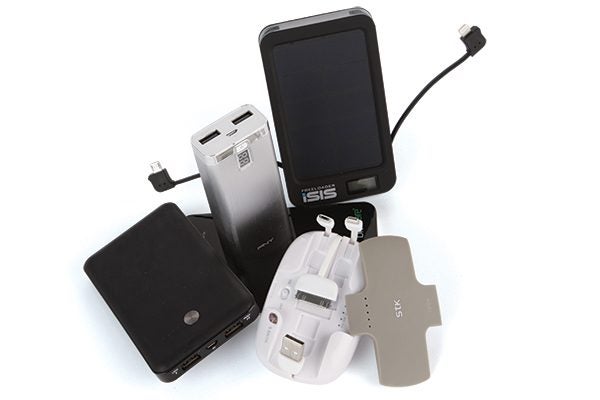We break down our top 5 portable battery packs, so you can be sure you'll never be left high and dry in the field
These days we all own smartphones and carry them with us constantly. While a few smartphones employ batteries that are designed to withstand regular use and still hold some charge after 24 hours, most require daily – if not twice daily – charging. That’s fine if you work in an office or are in easy reach of a mains supply, but if you’re out and about or travelling abroad then you might want to invest in a portable battery pack. These are small, portable batteries that can be used to recharge your phone (and other compatible electrical devices) on the go using a USB charging cable. They use li-ion battery chemistry as this allows for constant charging and discharging without degrading the battery’s overall capacity or adversely affecting its performance. Reputable brands also build-in circuit protection to ensure they are safe to use and won’t damage your electrical devices. You can even use them with some compact cameras that accept USB charging – just be sure to check your camera’s voltage/current requirements.
What to look for
Capacity: The capacity of a portable battery pack is measured in mAh and refers to the amount of charge it can hold. A battery pack with a higher capacity will enable you to charge your smartphone more times before you have to recharge the battery pack itself, but does result in a bigger and heavier device.
Output: Battery packs use USB ports to attach cables to devices that need charging. The speed at which power is moved from the battery pack to the device on charge is measured in amps. The average speed is around 2.1 amps, although some battery packs are capable of faster speeds.
Input: The best way to recharge your battery pack is via the mains using a USB wall adapter – just be sure to use one that meets your battery pack’s voltage/current requirements. As with output speeds, the faster the input current rating, the faster the battery pack will recharge.
Construction: Battery packs are designed to be carried around with you in a bag or pocket and used regularly, and therefore need to be durable. Premium and flagship packs tend to benefit from rugged aluminium construction, while cheaper models get a polycarbonate finish.
Here are our picks for the best portable battery packs:
1. Anker Power Core+ 10050 | £50
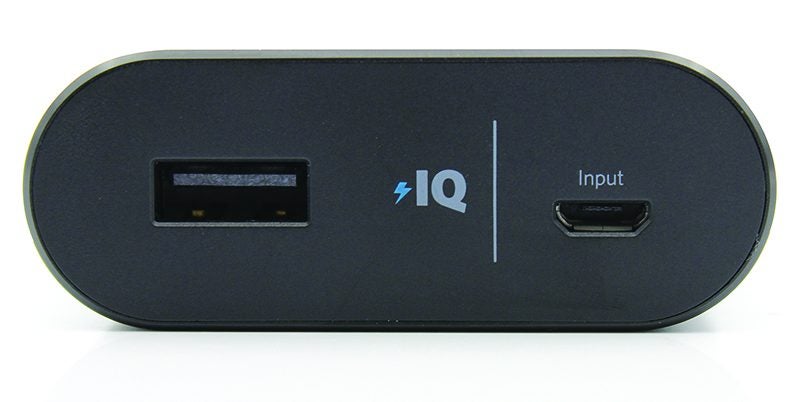
Key specs
- Power reserve: 10,050mAh
- Input: 5V/2A
- Output: 2x 2.4A
- Dimensions: 9.6 x 6.1 x 2.3cm
- Weight: 236g
Founded by a group of former Google employees in 2009, Anker is one of the biggest players in the portable battery pack market. In addition to portable chargers the company also manufactures a wide range of keyboards, cables, Bluetooth speakers and other accessories designed specifically for mobile devices. The PowerCore+ range is Anker’s flagship battery pack range and consists of five models: the 3,350mAh PowerCore+ Mini (£40), the 10,050mAh PowerCore+ 10050 (£60), the 13,400mAh PowerCore+ 13400 (£70), the 20,100mAh PowerCore+ 20100 (£80) and the 26,800mAh PowerCore+ 26800 (£90).
At the time of its launch last year, the PowerCore+ 10050 was billed as the ‘world’s smallest’ 10,050mAh portable battery pack. Rectangular in shape with softly rounded sides, the device is certainly impressively small and comfortable to hold. Whereas models further up the range offer two USB charging ports, the 10050 version (and those models below it) only comes with one. A micro USB port rests on the other side, which is used to attach the charging cable to charge the battery with. While Anker supplies a charging cable in the box that enables you to fill the PowerCore+ 10050 with power, you’ll need to use your own USB cable to connect any external devices that you want to charge with it.
The PowerCore+ 10050 benefits from a number of built-in technologies that are primarily concerned with maximising the output to attached devices in order to minimise charging time. Chief among these is Qualcomm’s Quick Charge 2.0, which allows compatible Qualcomm Snapdragon-equipped devices (as used in many Android phones) to charge up to four times faster. This is allied to Anker’s own ‘Power IQ’ output-maximising and ‘VoltageBoost’ cable resistance overcoming technologies that are also built-in. Combined, these three technologies enable the PowerCore+ to offer a maximum output of 2.4 amps. Recharging the PowerCore+ 10050 via a mains source requires a minimum 5V/2A USB wall adapter. Anker recommends using a Qualcomm QuickCharge 2.0 mains adapter for the very speediest recharge times. One minor gripe is that the PowerCore+ 10050 cannot be used in pass-through mode, which is to say it cannot be charged while charging another device.
Constructed from premium-grade Panasonic battery cells and US-made electronics internally, externally the Astro E1 benefits from a matte black aluminium outer casing that looks pretty stylish and feels good in the hand. Anker claims that all PowerCore+ models have undergone rigorous impact and temperature testing to ensure they won’t break down in extreme temperatures or as a result of accidental drops. While we can’t independently verify either claim, the aluminium casing and overall construction certainly feels robust enough to stand up to the rigours of daily use. The circular LED light display is a neat touch too, with the 10 individual lights that comprise it accurately displaying the device’s remaining power reserves in an intuitive clock-like fashion.
Verdict
Packed with technology and yet small enough to comfortably slip inside a trouser or jacket pocket, the Anker PowerCore+ 10050 is a brilliant little battery pack. Add to this a robust build quality and premium matte aluminium finish and the PowerCore+ 10050 is hard to fault. Indeed the only small thing holding it back is a lack of pass-through functionality, although for the vast majority of users this is never likely to be much of an issue anyway. For those looking for an impressively small and feature-packed portable battery charger to re-energise their mobile phone with, the PowerCore+ 10050 comes highly recommended.
______________________________________________________________________________________
2. Mophie Powerstation 3x | £50
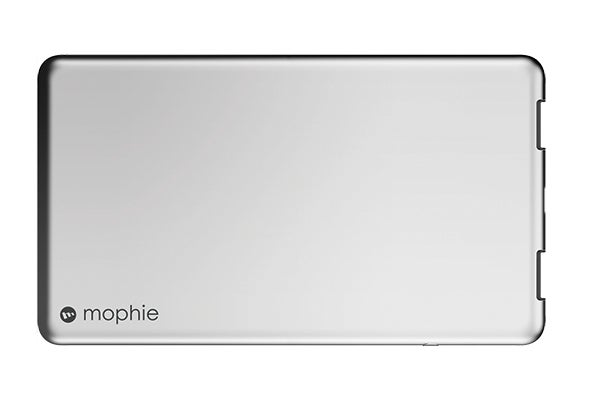
Key specs:
- Power reserve: 6,000mAh
- Input: 5V/1.5A
- Output: 2x 2.4A
- Dimensions: 14.3 x 8.2 x 0.8cm
- Weight: 175g
The Mophie Powerstation comes in five variants. The entry-level model is the Powerstation 1x (2,000mAh, £26) followed by the Powerstation 2x (4,000mAh, £37) and the 3x (6,000mAh), both of which are ideal for mobile phones and the like. Those with more power-hungry devices may want to look at the Powerstation 5x (10,000mAh, £78) or the 8x (15,000mAh, £90).
Internally, the devices use high-density power cells, which allow for a super-slim form factor. Externally they have a matt-finish aluminium casing that offers good protection from knocks. The 3x is also available in various anodised finishes including space grey, rose gold and gold, and is only slightly larger than an Apple iPhone 6s.
While the Powerstation 1x and 2x models both come with a single USB port, the 3x, 5x and 8x models all have dual USB ports that allow you to charge two devices simultaneously. The mid-range 3x can deliver power to connected devices at a maximum 2.4 amps, and it holds 6,000mAh –enough to charge a 1,715mAh iPhone 6s about three and a half times. Aside from the ultra-portable Powerstation 1x, all the models benefit from Priority+ pass-through charging technology, which allows them to deliver charge to a connected device while the Powerstation is being charged – the connected device will be charged first, followed by the Powerstation.
Mophie offers a free Mophie Power app that’s compatible with the 5x and 8x models. This will let you know the charge level of any connected devices along with the Powerstation’s status. Meanwhile the 1x, 2x and 3x models all have a power check button on the side, along with four LED battery indicator lights: four lights indicates a fully charged Powerstation, while one light tells you the Powerstation needs charging. All Powerstation models are charged via a micro USB port with a supplied micro USB to USB lead. While it’s undoubtedly slower, you can also charge the Powerstation by plugging the USB charging cable directly into the USB port of a computer.
Verdict
With a generous range of models to choose from, Mophie’s Powerstation range has a portable battery pack to suit all budgets and power requirements. The devices are stylish, well built and – in the case of the 1x, 2x and 3x versions – small enough to comfortably slip inside a pocket. While the 5x and 8x models are primarily geared towards tablet users, the 1x, 2x and 3x versions are ideal for smartphone users. Which one is right for you will depend on what you need to charge and how many times you might need to do so before you’re able to use a mains supply.
______________________________________________________________________________________
3. Onadaptr Flip Power Dual USB Charger and Powerbank | £30
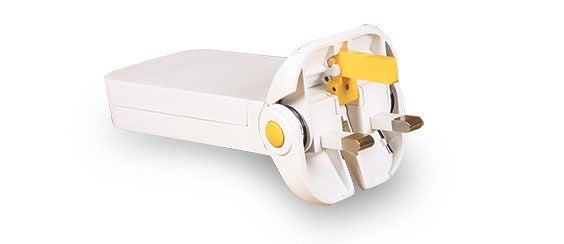
Key specs:
- Power reserve: 2,000mAh
- Input: 220-240v
- Output: 2x 3.4A
- Dimensions: 12.6 x 4.8 x 1.8cm
- Weight: Not available
Prior to the release of the Flip Charger, Oneadaptr had already made a name for itself with its innovative range of ‘Twist Plus’ travel plug adaptors for Apple MacBook laptops. The Oneadaptr Flip Power Dual USB Charger and Powerbank is a slightly different prospect that takes the humble three-pin UK plug as its starting point, and then completely redesigns it for the digital age. Essentially, it’s a miniaturised three-pin plug with two USB ports and a built-in battery pack for emergency power-ups on the move.
The developers claim the Flip Power device has taken over a year to develop, during which time funding has been provided by Kickstarter. Constructed from tough polycarbonate, the Flip Power folds down to a small rectangular box (48 x 18 x 126mm). This makes it easy to pack down and take with you when travelling. The two metal pins are housed within the device when folded down so they won’t be able to scratch any other items you might be carrying in the same bag.
To open the plug up, simply hold the plug in one hand and press the quick release buttons with the other. This will open the device to reveal a standard UK three-pin plug, with the neutral and live pins both constructed from conductive metal and the top earthing pin constructed from plastic. At the other end you will find two USB ports, each of which is capable of outputting a super speedy 3.4 amps to your mobile phone, tablet and other digital devices. Better still, the Flip Power also encompasses a built-in battery pack that can hold up to 2,000mAh of charge for emergency power-ups on the go. For maximum flexibility the Flip Power can power a connected device when plugged in while simultaneously charging its own built-in battery pack.
There are two further models in the Flip series; one that offers two USB ports (the Flip Duo) and one that offers four USB points (the Flip Quad). Unlike the Flip Power, though, neither of these has a built-in powerbank.
Verdict
The Flip Power Dual USB Charger and Powerbank is an innovative device that serves as both a standard three-pin-plug-to-USB adapter and as a portable battery pack. While 2,000mAh of reserve power isn’t a huge amount, it definitely adds to the overall functionality of the device. Overall, the Flip Power is a neat solution for owners of digital devices who want an easily portable plug that can also supply some additional reserve power to mobile devices when there isn’t a mains plug to hand.
______________________________________________________________________________________
4. Jackery Giant+ 12,000Ah | £70
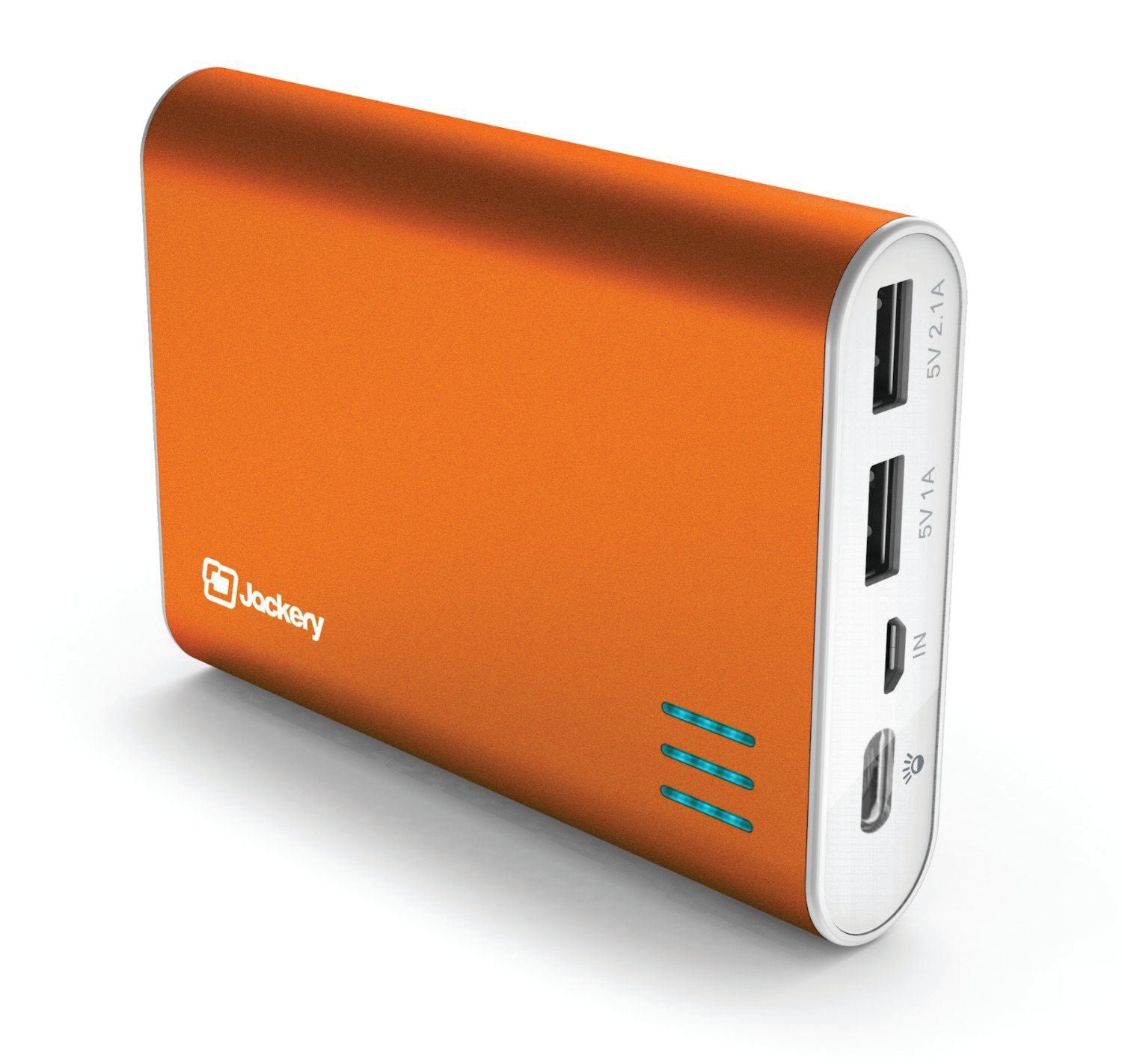
Key specs:
- Power reserve: 12,000mAh
- Input: 5V/1.5A
- Output: 1x 2.1A, 1x 1A
- Dimensions: 10.9 x 7.9 x 2cm
- Weight: 386g
Founded in 2010 and operating out of Silicon Valley, USA, Jackery is firmly established as a major player in the portable charging market. The company makes a wide range of portable battery packs that hold between 3,000mAh and 20,100mAh of power. Jackery battery packs have gained a reputation for being solidly built and nicely finished, in addition to which they come fitted with Panasonic Grade A li-ion battery cells and several layers of built-in safety protection circuitry.
The Giant+ sits towards the top of the company’s range, with only the Jackery Titan (20,100mAh) offering more in the way of capacity. Available in a silver, black, orange or gold finish, the Giant+ looks especially stylish in orange and even comes with a built-in LED flashlight that can be turned on by double clicking the main power button. Three LED striplights on the top of the device indicate power reserves. In terms of construction the main outer casing is fashioned from aluminium, with each end given a polycarbonate finish. The overall impression is of a well-made and durable device.
The unit offers two USB ports, each of which is designed to discharge power at a slightly different rate: one is rated at 1 amp while the other is rated at 2.1 amps. Which one is right to use will depend on the type of device you wish to charge. As a general rule though, most smartphones and tablets will charge faster when connected to the 2.1 amp port. In addition to charging single devices, the Giant+ can also be used to charge two devices simultaneously. A maximum output of 3.1 amps means both USB ports will continue to output at their maximum speeds when two devices are connected. Sadly, the Giant+ does not support pass-through charging though.
The Giant+ is recharged via the micro USB port that’s positioned to the side of the twin USB ports. This can draw current at a maximum of 1.5 amps and requires a 5V/1.5 amp USB wall adapter (not supplied) should you want to charge it via a mains connection.
Verdict
For those looking for performance and value for money the Jackery Giant+ is hard to fault. While it is noticeably bigger and heavier than the Anker PowerCore+ 10050 it does hold slightly more charge, which could prove useful, especially for tablet or other power-hungry users. In addition, the ability to charge two devices simultaneously at maximum speed is also welcome.
______________________________________________________________________________________
5. RavPower Triple iSmart 2.0 | £50
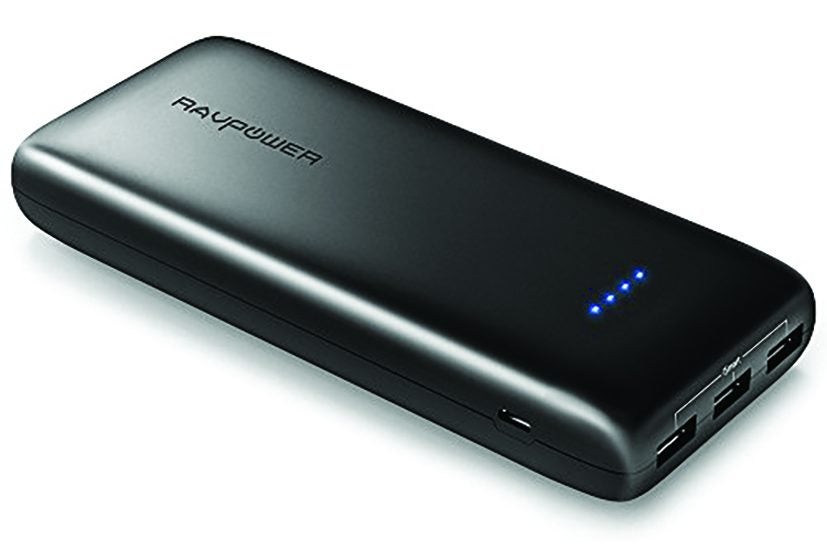
Key specs:
- Power reserve: 22,000mAh
- Input: 5V/2.4A
- Output: 3x 2.4A
- Dimensions: 16.5 x 7 x 2.4cm
- Weight: 406g
Founded in 2011 and based in the USA, RavPower offers a huge range of portable battery packs, from pocket-friendly 3,200mAh devices to larger 26,800mAh battery packs that can charge an iPhone 6 up to ten times on a single charge.
The big draw with the RavPower iSmart 2.0 is that it is one of only a few battery packs on the market to come with three iSmart 2.0 USB ports. All three benefit from a maximum output of 2.4 amps per port and can be used simultaneously for a combined total of 5.8 amps. The RavPower Triple further benefits from iSmart 2.0 technology that automatically adjusts voltage and current thereby allowing connected devices to draw power at their optimal rate.
The micro USB charging input is located on the side of the device and is used to recharge the RavPower Triple via a supplied cable. This input is rated at 2.4 amps which, given the battery’s huge capacity, is a sensible decision as it enables the device to be fully recharged in around 10 hours. Had RavPower opted for a typical 5v/1.5 amp input, as used on many lower capacity battery packs, then charging times would be considerably longer than 10 hours. Passthrough charging is also supported, so you can charge the RavPower Triple while it is charging connected devices.
Panasonic’s Smart IC power management is also on hand, alongside nine other types of built-in protection to ensure the RavPower Triple itself (plus any connected devices) are adequately protected against overheating, surge damage and short circuits. Units are also rated for up to 500 full recharges and discharges for an impressively long life expectancy. Construction impresses too, with RavPower claiming that the Bayer-made fire-resistant thermoplastic casing is the same material that Mercedes and BMW use on their cars. At 406g there’s a reassuring weight to the device too. The top plate is also fitted with four blue LEDs that are used to indicate the device’s power reserves.
Verdict
If you’re looking for a family-sized battery pack that can keep multiple devices charged on long journeys or extended camping breaks then the RavPower Triple fits the bill perfectly. With its three 2.4 amp USB outputs, the RavPower Triple can recharge up to three devices at once and can do so as efficiently as possible. While recharging the unit does take quite a long time, once fully charged it’ll keep the average smartphone user comfortably off-grid for around a week. At around £50 it’s great value too.





